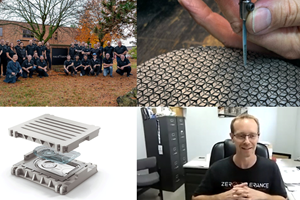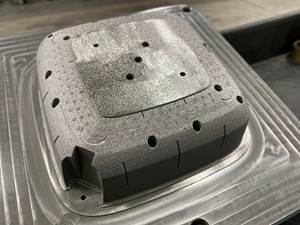Procter and Gamble's Corporate Donation Propels RP Research into the New Millennium at the Milwaukee School of Engineering
Procter & Gamble donated more than 40 U.S. and international patents to the Milwaukee School of Engineering.
Late last year, Procter & Gamble made one of its largest corporate donations ever - more than 40 U.S. and international patents with accompanying intellectual property - to the Milwaukee School of Engineering (MSOE), pioneers in rapid prototyping research and system applications.
The patents comprise Procter & Gamble's proprietary PHAST (Prototype Hard and Soft Tooling) technology, which drastically reduces the time it takes to design molded parts in a wide variety of industries, pushing products into the marketplace faster. According to P&G Chief Technology Officer Gordon Brunner, "A world-class technology like PHAST needs a world-class leader in rapid prototyping to develop it. MSOE is that leader."
MSOE Dean of Applied Research Tom Bray says that Procter & Gamble selected the university unbeknownst to them. "They hired a consultant - an expert in the rapid prototyping field not connected to any one business or technology - to do a survey of the entire U.S. university population," he explains. "The consultant then selected a number of schools, and from that group, he picked two or three that were the top schools, and we were among them - because of our ability to use, develop and market this PHAST technology. While we knew nothing of this technology, what we have been doing for several years is developing moldmaking technology on our own for casting, injection molding, etc."
Procter & Gamble then made site visits to the top few schools before selecting MSOE. "I believe one of the major reasons we're successful is that we have involved a tremendous number of students in this that are supported by an extraordinary staff," Bray states. "We bring students in from around the country under sponsorships by the National Science Foundation. It's called the Research Experience for Under-graduates program, and they come in and do research in tooling, architecture, bio-molecular modeling and medical modeling. We are continually fabricating real-world objects and molds."
The possibilities with the PHAST technology are endless, Bray feels, and will help further research and development at the school's Rapid Prototyping Center (RPC) and the Rapid Prototyping Consortium, both established in 1991. "We are in the process of transferring the technology from P&G to the RPC," Bray comments. "What we know about PHAST right now is that it will be for prototype quantities - it is still unknown if it can be used in production quantities. Our first step is to reproduce the process on campus - there's no way we can license it out unless we know how the process works and what its qualities and characteristics are. We will make real molds and real parts for real clients."
According to Bray, MSOE is the only university in the country to utilize the four major prototyping systems at the RPC - stereolithography (SLA), laminated object manufacturing (LOM), selective laser sintering (SLS) and fused deposition modeling (FDM). "We're taking all forms of these materials - liquids, powders and solids - and merging them," Bray comments. "We are generating a tremendous amount of intellectual property - all kinds of geometries and material combinations, and some of these are going to be patented.
"People who walk into the Center are blown away - I don't care if they are five years old or 85 years old, whether they are an engineer or a nurse, they see models of all kinds of things," Bray continues. "We're doing a tremendous amount of development - applied toward moldmaking, toolmaking and model making."
The partnership between Procter & Gamble and MSOE promises to be an exciting one, full of surprises and challenges as MSOE strives to make the most of PHAST technology. Bray says that a number of companies worldwide have already contacted him regarding the new technology. "We didn't envision all of this when we started - we're just reacting to all of the possibilities out there," he states. "This is where moldmaking is headed - we are moving into some uncharted territory - and the sooner the industry knows it, the better."
Related Content
4 Keys to a Successful Mold-Building Operation, The Latest Mold Design Tips & More
MoldMaking Technology is off to a strong start this year with mold design tips, key considerations for running a mold-building “business,” polishing pointers for ribs and more. Check out our list of top-viewed articles from January and see what catches your eye.
Read MoreA 3D Printing Retrospective
A personal review of the evolution of 3D printing in moldmaking throughout the past 25 years.
Read MoreHow to Supply Cooling to Additive Tooling
Additive tooling provides limitless options for cooling a mold’s difficult-to-cool areas.
Read More3D Printing Innovates Hot Runner Manifold Design
Metal 3D printing combined with a conventionally machined manifold block overcomes flow shadows on valve gates and offers faster color changes while providing closer system pitch centerlines between cavities.
Read MoreRead Next
Reasons to Use Fiber Lasers for Mold Cleaning
Fiber lasers offer a simplicity, speed, control and portability, minimizing mold cleaning risks.
Read MoreHow to Use Continuing Education to Remain Competitive in Moldmaking
Continued training helps moldmakers make tooling decisions and properly use the latest cutting tool to efficiently machine high-quality molds.
Read MoreHow to Use Strategic Planning Tools, Data to Manage the Human Side of Business
Q&A with Marion Wells, MMT EAB member and founder of Human Asset Management.
Read More


















